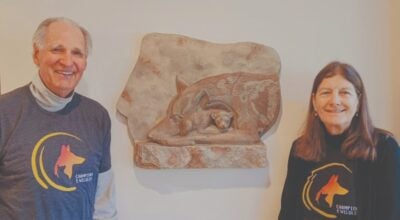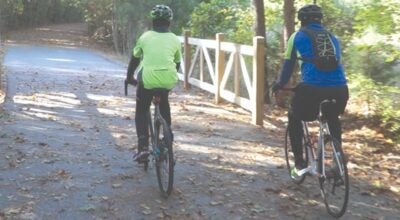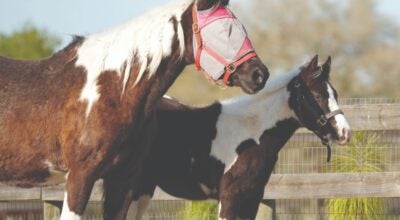Life in our Foothills September 2022 – Magnolia Trails
Published 12:47 pm Wednesday, September 28, 2022
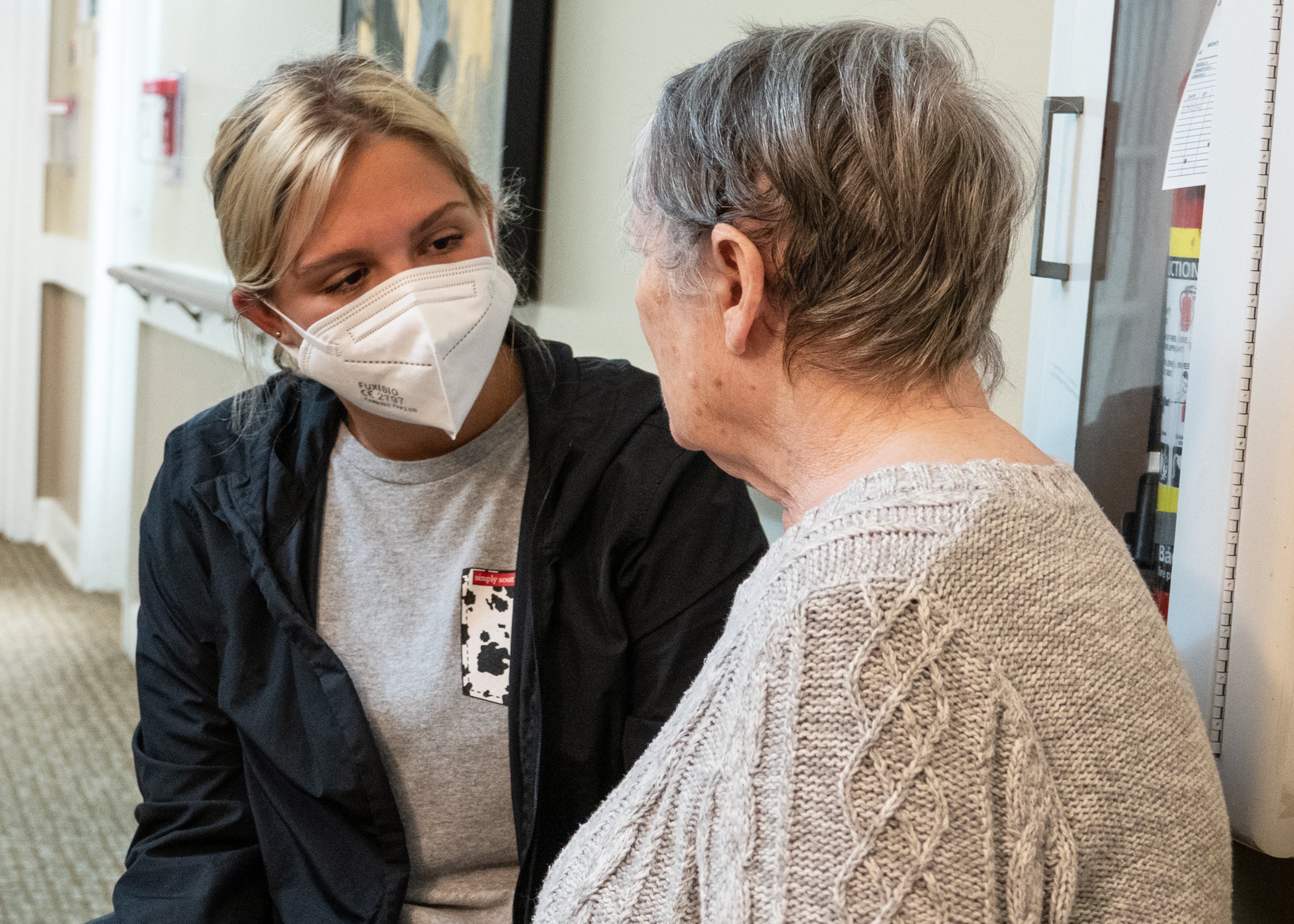
- Destiny Summer, CNA chats with Linda.
|
Getting your Trinity Audio player ready...
|
A New Way of Helping Memory Care Residents at LaurelWoods
The idea of writing about a memory care program at an assisted living facility never crossed my mind until it became personal. Reporters learn early on that they’re supposed to stick to the facts. “Keep your personal thoughts out of the story,” I’ve been told. But this story is different. I’m thankful that the brass at Life in Our Foothills gave me the freedom to write this accounting of the last few years of my life and how a unique program is making a difference for a loved one.
I will shorten all the details. Our lives changed after my wife, Bobbie (nickname for Barbara), suffered a couple of strokes in 2009. While I thought she came through those strokes in good shape, I was mistaken. Time was taking its toll. Things she used to do became more difficult. Riding Doc, her beloved quarter horse, was impossible. The best she could manage was to wave at Doc from the back porch. Occasionally, she would get the strength to make it up to the barn to give him a couple of carrots.
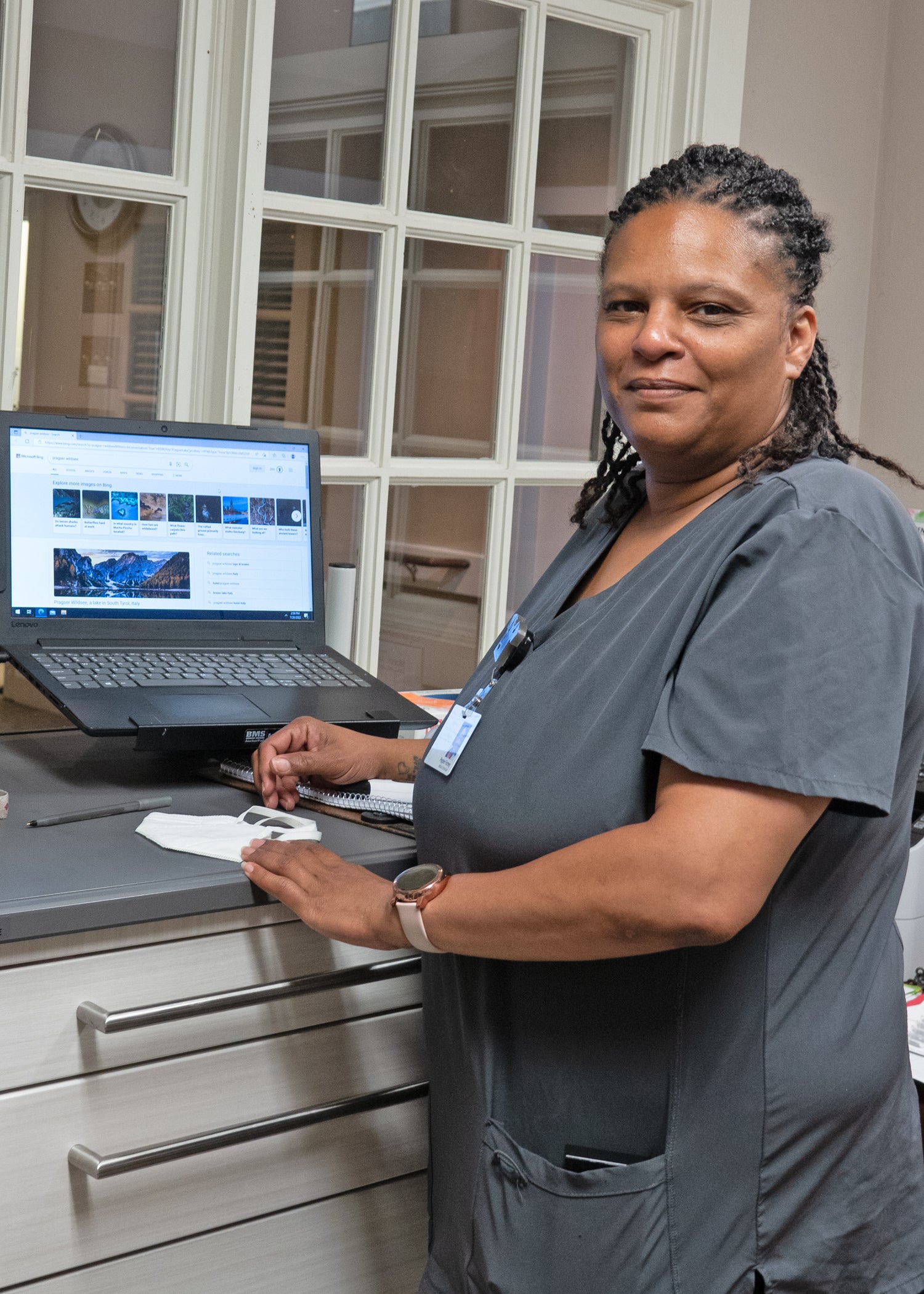
Pepper Forney, med tech for Magnolia Trails. Pepper has worked at LaurelWoods for 17 years.
It was a few years after her strokes when I started realizing that Bobbie was getting forgetful. I’m not sure when her doctor first mentioned the “D” word to me, but it was obvious that her life was changing. Things made a little more sense when her doctor confirmed the dementia diagnosis. While the timing can never be “good,” it was fortuitous that I was retiring just as her cognitive skills were declining at a faster rate. I was home and could be there to take care of her.
It was the winter of 2021 when I knew I was in over my head. I’m no cook but much to Bobbie’s dismay and possibly amusement, I was providing three meals a day. I’m sure she was wondering why I never signed up for the local “men’s cooking class.” Daily laundry, housecleaning, and animal care all fell to me. All this work gave me a new respect for all the moms (and many dads) who do this and more day in and day out.
Bobbie continued to have issues with short-term memory. But now I was also starting to see lapses in her long-term memory. I remember one afternoon when she asked me when was I leaving. I’m guessing she was thinking I was “the help.” I said, “Bobbie, I live here. We’ve been married 40 years.” Without missing a beat, she answered, “Do you have proof of that?” Well, I did. We happened to have a framed wedding announcement. I brought it over for her inspection. I don’t think she was convinced.
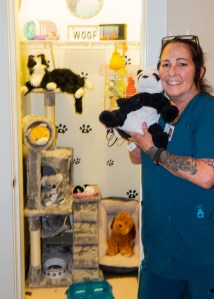
Sandy Clark, full-time housekeeper for Magnolia Trails, shows off one of the pets from the pet room – one of the life skills stations.
It was time to look for help. I first had a private caregiver three hours a day, three days a week. After a couple of months, that person quit. I decided to try an agency. I started with four hours a day every other day. But it wasn’t long before four hours evolved into eight hours seven days a week. Even that was not enough.
Bobbie’s sister, Bobbie’s doctor, and I knew that a full-time residential program was the next step. Her sister (Pam James) and I visited several assisted living facilities in the area. We weren’t thinking “memory care.” We were overconfident in thinking that Bobbie could manage in a regular assisted living program.
We ended up choosing LaurelWoods, the assisted living community in Columbus. She was accepted and was given an opportunity to try assisted living – the level of care where the resident can take care of most things but might need a little extra help with medications, getting dressed, or other needs. They offered extra levels of care and I just figured Bobbie would need the highest level. But it was nice to think of her in this assisted living wing and not needing to be “classified” as requiring memory care.
The assisted living honeymoon lasted just four hours. My phone rang and I was informed that Bobbie had “eloped.” Maybe that’s not quite the right word but that’s what I heard. I didn’t think she had taken off with a new boyfriend –after all, she had only been there a few hours and it took longer than that to woo me. The staff quickly explained it meant she had fled the coop. After her first lunch, she decided to take a walkabout, found a door, and went outside to sit on a bench. She really didn’t know where she was. When staff found her a few minutes later, Bobbie said she was waiting to be picked up. I was told that Bobbie would have to move into their memory care wing.
And then, just like that…Bobbie moves from the somewhat feeling of being independent to being in a wing with locked doors. All memory care units must have locked doors to keep residents from eloping and endangering themselves. They can move freely within the unit itself including going outside into a large and sunny courtyard.
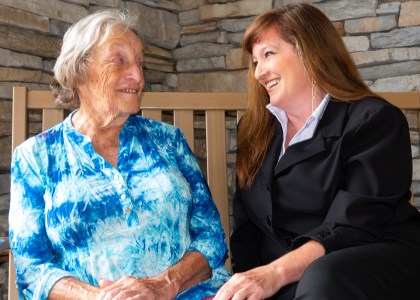
Executive Director Ann Watts chats with assisted living resident Caroline out on the front porch of LaurelWoods.
We had chosen LaurelWoods because it had a homey atmosphere and Bobbie liked the sound of the food choices on the menu. Anything had to be better than what I had been serving. We had to move her from the room her sister had decorated to another room in a different part of the building. It took a while for me to get used to the idea of Bobbie living in memory care. To Bobbie, it didn’t matter – but to me, I was a bit depressed each time I left to go home. It just didn’t seem like the place for Bobbie. I felt like I had let her down. I kept doubting my decision to move her there.
The memory care unit seemed cheery and the staff was certainly professional. But I left each visit feeling like it just wasn’t living up to my expectations. I knew they were doing more for Bobbie than I could. I knew she would be looked after 24/7. But still…something seemed missing.
But within a few months, I could see changes in the way the memory care unit was adapting the way it helped the residents. The program was being transformed from a traditional memory care unit to a village called Magnolia Trails. Some of the changes were subtle and others quite dramatic. All these changes had been carefully thought out by professionals working with dementia and Alzheimer’s patients. It is a program used by all the properties managed by Sonida Senior Living, the parent company of LaurelHurst-LaurelWoods.
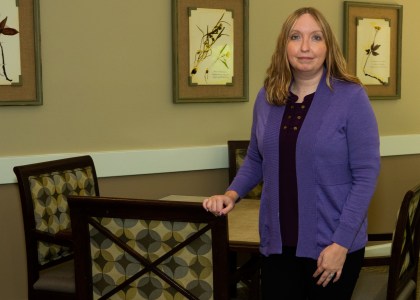
Sue Dodge, Magnolia Trails Director.
Sue Dodge (Magnolia Trails Director) and Ann Watts (LaurelHurst-LaurelWoods Executive Director) were more than happy to fill me in on some of these changes.
Magnolia Trails is a whole new way of working with memory care residents. The program is designed around a homelike environment meant to help residents who are having any level of memory impairment. It could be the early stages of dementia and it includes loved ones with Alzheimer’s. Focusing on Care First is one of the Five Pillars of the Magnolia Trails program and it’s obvious. The staff, all of them, are true believers in “walking the talk.” Ann Watts explains how just taking five minutes to chat with a resident makes such a difference. She says, “In that five minutes a staff member can learn five things about that person and those five things become five ways to engage the residents in many situations.” It helps break the ice and helps the residents feel safe and comfortable.
Magnolia Trails has its own dedicated program director, Sue Dodge. She loves her job and like any job, there can be challenges. She says, “Just because you have an activity planned doesn’t mean a resident will participate. A friendly smile, a good choice of words, and a genuine personal invitation can make all the difference.”
Sue is assisted by a competent staff that is specially trained to work with this population. Of course, there are CNAs and loving caregivers who are the day-to-day folks who make it their mission to make the Magnolia Trails folks feel comfortable and safe. The neighborhood also includes its own med techs, its own full-time housekeeping person, and its own dining room assistant. A couple of registered nurses are on staff serving the whole campus and are always on call in Magnolia Trails. A physician makes rounds on a weekly basis. Physical and occupational therapists make regular visits.
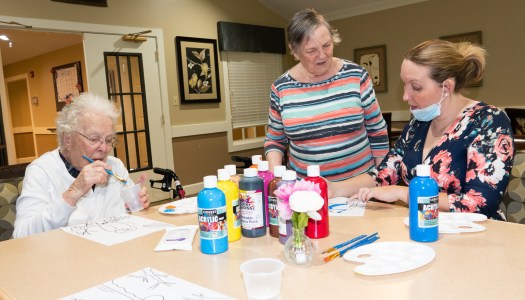
Magnolia Trails Director Sue Dodge helps Ester and Linda get started on a painting session.
Everything about the neighborhood has either been transformed for this new Magnolia Trails program or is still a work-in-progress. Each change has a thought-out reason, and the benefits are noticeable. The activities room not only has new furniture, but the sofas and chairs have been rearranged so that residents aren’t just facing the large TV screen. Instead, the sofas and chairs are set so that residents can casually interact with each other instead of being mesmerized by the TV.
Just a walk through the hallways of the Magnolia Trails neighborhood is a treat. The 16 rooms, sometimes referred to as apartments, are arranged around a continuous rectangle. If a resident gets confused about getting “home,” all they must do is take a stroll in either direction and they’ll get there. If not, a staff member will guide them. A few months ago, only a room number and a small nameplate marked a resident’s room. Today, next to each door is a shadowbox with a photo or two of each resident to make recognizing the room instant. Some residents might not remember a room number, but they’ll always recognize those photos.
Another striking improvement in the transformation from memory care to Magnolia Trails has been the addition of “life skills” stations. While the idea of these stations isn’t new and most other facilities would have something similar, Magnolia Trails took it to a whole new level. Under Sue’s and Ann’s direction, they commandeered six small utility closets interspersed throughout the neighborhood and converted each into cute interactive rooms with a theme to help engage the minds and spark memories. One resembles a pet shop with various toy animals that residents can pick up and hold and even take to their room. A favorite life skills room is the music room with some rhythm instruments, an old-fashion radio, and walls covered with posters, album covers, and vinyl records by music stars from their past. There’s a Man Cave with a few toy tools and even some “pin-ups.”
It has been a little over a year since Bobbie became a resident. I can see the differences the Magnolia Trails program is making. I no longer second-guess the decision to move her there. With these changes I’ve mentioned, others not mentioned, and still others being implemented – it’s become a magical place.
Nothing is going to “fix” Bobbie’s dementia, but I feel certain the staff at Magnolia Trails is going to make sure her days are interesting, her needs are met, and she’ll be loved.
Five Pillars of Magnolia Trails™
- Focusing on Care First
- Creating the Environment
- Embracing Moments
- Making Family Connections
- Providing Food and Nutrition
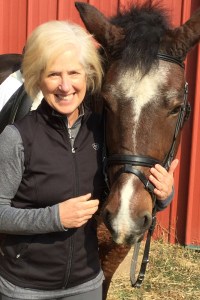
Tootie Stoehr with Ayla, her therapeutic riding horse.
“A childhood friend of mine has been a resident of LaurelWoods in the memory care unit for the past year and a half. As a practicing speech-language pathologist who also works with the dementia population, I am always on the lookout for new approaches and ideas to help me provide the best care I can for my clients. Huge kudos to LaurelWoods for implementing the Magnolia Trails program to use in the memory care unit! When I visit Bobbie, not only do I get to use their materials to promote conversation with her, but also have materials to use to redirect or include other residents who are curious and attracted by our many outbursts of laughter!” – Tootie Stoehr
For More Information:
LaurelHurst-LaurelWoods is located at 1064 West Mills Street in Columbus across from St. Luke’s Hospital.
For admissions info, contact Krystal Toney at (828) 894-3900. (ktoney@sonidaliving.com)
You can find more information about the Magnolia Trails program on their website: https://www.sonidaseniorliving.com/community/laurelhurst-and-laurelwoods/
Check out their Facebook page: https://www.facebook.com/LaurelHurstandLaurelWoodsNC



